| Pages:
1
2 |
BeerChloride
Harmless

Posts: 47
Registered: 17-9-2006
Location: Alabama, USA
Member Is Offline
Mood: Dunno
|
|
Making mantles and glas-cols.
This all started with my "smelly glas-col" post
http://www.sciencemadness.org/talk/viewthread.php?tid=6754
where I discussed disassembling and reassembling a glas-col mantle. Since they sell for over $100 USD, I thought about making heaters. Here is what I
found so far: will add more info as I find it.
I was inspired by the DIY stirrer link:
http://www.sciencemadness.org/talk/viewthread.php?tid=3056
In particular, BrainFever's mantle project which uses concrete. I bought a 10 pound bag of "quickcrete" for $1.88. Another useful material is muffler
and tailpipe putty available at AutoZone or elsewhere. It is sodium silicate and crystaline silica. Somewhat brittle but still strong, useful as high
temp "glue" and should withstand up to 1000 C.
For flexible heating elements as in glas-col, the elements are resistive wire wound around a fiberglass core, then sheathed with fiberglass
insulation, then that element is circled in a spiral. The specification from glas-col gives a maximum element temperature of 450 C. Note: TYPICAL
high-temp fiberglass wire insulation is usually acrylic coated, and therefore goes to something like 240 C. What is needed for direct contact with the
heating wire is non-coated fiberglass. There is a product called "thermosleeve"
http://www.adlinsulflex.com/fire-sleeves/thermosleeve-b/
which is rated for 538 C continuous use. I don't know if the last link will sell small quantities. I found a different supplier of some kind of
fiberglass sleeve, not sure what manufacturer, though:
http://www.sollerpaddles.com/composites/carbon%20fiber%20sle...
They sell 1/4" sleeve which they rate to around 650 C. Now, it seems that this size actually goes from .09" to .29" as it stretches. It is only 44
cents/ft.
It would be nice to find a supplier of that fabric they use in glas-cols. I still don't know if it might be asbestos? The only thing I've run across
so far is the fiberglass cloth used for fiber/resin repair work. It will work, but it's just not as good as the official material.
Here's a rundown on HEATING ELEMENT DESIGN using nichrome or other wire:
I won't go into details, but V=IR, P=IV, and R=(rho)(s/A), where s is the total actual length of wire used.
1. Determine power limit
2. Choose max voltage (i.e. 115 v)
3. 1 and 2 determine the R (hot) needed, and the current I
4. you want a large r (wire radius) for strength & durability but..
5. Since R and rho (resistivity) are fixed, there's a tradeoff between length and diameter of wire (A=pi r^2)
6. Determine max temp Tm of the heating element
7. For a given wire gauge, R = s LR (LR, linear resistance, can be found from chart or calculated)
8. For coiling, s^2 / L^2 = 1+(pi d / p)^2 , where s is the wire length, L is the coiled element length, d is the winding diameter, p is the winding
pitch
A regular light dimmer can usually control up to 600 watts (which I wouldn't use for more than 300-400), so power control is a consideration. The
specs from glas-col have the 100 ml size hemisphere at 80 watts. For a straight wire in air, the radius actually needs to be determined from Tm and
the current (from a chart). For the same power rating, a thinner, shorter wire will be hotter than a thicker longer wire. A table for
temp-radius-current , as well as a gauge-LR chart exists here:
http://www.wiretron.com/nicrdat.html
However, in reality an element will not be straight, and will be in thermal contact with the mantle, so I think the temperature will actually depend
in on how "compactified" the element is.
So, once you have the total wire length, you then need to figure out how to pack into the space available. That is why the heating element in a
glas-col is coiled. Don't forget that nichrome's hot resistance (@~450 C) will be about 4% higher than the cold resistance.
Here's an example. For an 80 watt, 115 V heater, R(hot) will be 165.2 ohm. I think 36 gauge would be about as thin as I would want to go. I want
Tmax=450 C (but not sure what actual will be). The cold resistance is therefore 158.6 ohm, and 30 gauge nichrome (6.5 ohm/ft) needs 24.4 ft. Then, if
I want an element length of 3 ft, I should aim for a winding d of 0.1" and pitch of .039" . That 3 ft will be formed into a spiral.
I might buy some of the fiberglass tubing, and ebay seems a good source for nichrome wire. Then, a heating element could be as simple as winding the
right length onto some fiberglass tube, then pulling more tube over that, and then forming a spiral. This could also be a way to replace the element
in a glas-col (if you're willing to take one apart! No, that's the easy part - I mean if you're willing to sew one together.)
[Edited on 10/1/2006 by BeerChloride]
[Edited on 10/2/2006 by BeerChloride]
|
|
|
not_important
International Hazard
    
Posts: 3873
Registered: 21-7-2006
Member Is Offline
Mood: No Mood
|
|
I believe that the material used in these is a borosilicate glass fiberglass. Ordinary soda-lime glass softens at too low of a temperature.
Portland cement or concrete has the disadvantage that heat dehydrates it, causing it to weaken and fall apart. It is also not a very good insulator,
although this can be improved by using perlite is the aggregrate in the mix with cement, rather than the more common sand and/or pebbles.
t least some of your URLs are bad - just http:///
|
|
|
BeerChloride
Harmless

Posts: 47
Registered: 17-9-2006
Location: Alabama, USA
Member Is Offline
Mood: Dunno
|
|
Yea I think i fixed the urls.
Borosilicate fiber - could be.
Portland cement should be a good enough insulator to hold a heating element. The idea would be to definitely place more material (fiberglass, etc)
over the heating element. One thing that occured to me, though, is the use of the muffler putty in a mantle. Sodium silicate is water soluble, so
something spilled into it could weaken it. But it's used underneath cars, so maybe I just need to test some.
|
|
|
leu
Hazard to Others
  
Posts: 368
Registered: 13-10-2005
Member Is Offline
Mood: No Mood
|
|
This design works fine but takes quite awhile to construct and has a limited lifespan:
lugh
(Moderator)
02-02-03 00:53
No 403446
DIY OTC Heating Mantles
Heating mantles can be constructed using easily available materials. They're quite brittle, but very serviceable and are based on the fact that
Johns-Mansville marketed insulating bricks called Sil-O-Cel made from diatomaceous earth in days of yore 
1) Obtain a suitable length of nichrome wire, and wind it into a coil.
2) Support your flask with the neck down, and paint the bottom (which is now up) with melted paraffin/wax.
3) Mix equal volumes portland cement and diatomaceous earth in a suitable container, such as a plastic gallon milk jug with the top cut out, add a
little water at time and mix until you get a thick paste of cement, then apply it to the waxed portion of the flask, building up a thin layer of
insulating cement
4) Once you have a dry layer of cement, mix up more and start to embed the coil of nichrome wire in the cement, you may have to use various mechanical
means to force the coil to stay in place, such as starting out in a plastic bucket a little wider than the flask, and use shims to hold the coil in
place, or plastic ties, or weights on the unembedded coil etc
5) Continue to mix and apply cement until you have a mass of cement with just two ends of the nichrome wire sticking out, it's best to keep them
relatively close, without actually touching.
6) Once it's dried, stick the end of a steam generator line into the flask, which will melt the paraffin/wax, and release the flask.
7) Remove as much of the wax from the mantle as possible.
8) Bake the mantle in the electric oven for a few hours at 250 degrees Fahrenheit.
9) Attach an electrical cord to the two ends of your nichrome wire coil, using aluminum/copper crimp on connectors with the plastic removed.
10) Use a variable transformer/rheostat/dimmer switch to control the amount of heat generated.

[Edited on 1-10-2006 by leu]
Chemistry is our Covalent Bond
|
|
|
BeerChloride
Harmless

Posts: 47
Registered: 17-9-2006
Location: Alabama, USA
Member Is Offline
Mood: Dunno
|
|
That's an interesting method. But why does it have such a limited lifetime?
|
|
|
BeerChloride
Harmless

Posts: 47
Registered: 17-9-2006
Location: Alabama, USA
Member Is Offline
Mood: Dunno
|
|
Glass Cloth
Labor to find!! Here's one company (call-for-sales type..) with some good-sounding cloth:
http://www.agismfg.com/html/cloth.html?source=google
Regular glass cloth for resin work you buy at autozone is 6 oz/sq yd. This next links sells retail online 38.5 oz cloth:
HERE
I think it's still basically simple-woven though.
|
|
|
not_important
International Hazard
    
Posts: 3873
Registered: 21-7-2006
Member Is Offline
Mood: No Mood
|
|
A friend pointed me at these, you may find a similar local outlet. It may be overkill for heating mantles, more useful for tube furnaces.
Castable refractories. These could be used to line a cement+diatomaceous earth/perlite shell for longer life. This stuff withstands the heat better
and is stronger, while having better insulating properties.
The lower the density, the better insulator it is. The higher the density, the stronger it is.
http://www.seattlepotterysupply.com/Merchant2/merchant.mvc?S...
High temperature fiber stuff. Used directly against the heating wire. Heaters for fractionating columns have been made by wrapping the ceramic 'paper'
around the column, then the heating wire of the paper, this keeps the wire from fusing to the glass.
http://www.seattlepotterysupply.com/Merchant2/merchant.mvc?S...
[Edited on 2-10-2006 by not_important]
|
|
|
BeerChloride
Harmless

Posts: 47
Registered: 17-9-2006
Location: Alabama, USA
Member Is Offline
Mood: Dunno
|
|
Sounds like some good fairly inexpensive materials. I wish they had some pictures - their fiber "rope" might be a candidate for stitching for a
glas-col. I may be requesting samples..
I sheepishly post this:
Use of house insulation
I wondered about wall insulation for stuffing, etc. Owens-Corning "pink" insulation is made with a phenolic resin binder which makes it pink. Phenol
and formaldehyde I believe. Thus it should not be heated as is. However, phenolic resin decomposes with strong acid. So if you REALLY wanted to maybe
put some of that yukky brown drain-cleaner sulphuric acid to use, you could soak pink fiberglass in it to clean it. I tried it with a sample, and in a
few minutes made it lose most of the color. It would probably need more time/heat though. Then maybe some final cleaning step.
However - it's probably ridiculous to do that. Insulation with no binders added should be obtainable at home improvement centers.
|
|
|
not_important
International Hazard
    
Posts: 3873
Registered: 21-7-2006
Member Is Offline
Mood: No Mood
|
|
| Quote: | Originally posted by BeerChloride
Sounds like some good fairly inexpensive materials. I wish they had some pictures - their fiber "rope" might be a candidate for stitching for a
glas-col. I may be requesting samples..
... |
The rope is frequently used in kilns as a door seal, something like that around the door of a kitchen refrigerator. That which I've seen resembles
the ropes used to form lines and block access atr posh restaurants and theaters.
Pictures? Look here
http://www.armilcfs.com/pages/products.htm
http://www.alibaba.com/catalog/10796359/Ceramic_And_Glass_Fi...
http://www.nonmetals.com/Acf.htm
http://www.graphitestore.com/items_list.asp/action/prod/prd_...
Maybe we can get our budding entrepreneur to investigate distributing some of these 8-)
|
|
|
BeerChloride
Harmless

Posts: 47
Registered: 17-9-2006
Location: Alabama, USA
Member Is Offline
Mood: Dunno
|
|
Connectors
It took a long time, but I tracked down twist-lock connectors. I'm not sure if these are the exact ones used on glas-col. I don't have a connector for
reference. It seems like the glas-col ones are smaller. Anyway, the product I found is made by Hubbell. The spec page is HERE with pretty pictures (scroll down and click on catalog page B2). Part #s are HBL7465v and HBL7464v.
Few retailers seem to carry them: Allied, plccCenter, and Newark. At Allied, the male plug is $11.72, female end is $13.57. Here's the link:
Allied
Whew! Looking at around $32 to get a connector set! It really makes me sick sometimes trying to buy ONE special part. You know that glas-col probably
spends one or two bucks apiece for their connectors.
|
|
|
not_important
International Hazard
    
Posts: 3873
Registered: 21-7-2006
Member Is Offline
Mood: No Mood
|
|
I don't think you really need twist-lock connectors, although they are handy. Consider the style used on PC motherboards, there are versions that are
for connecting cables instead of sitting on a PCB. Say like these http://dkc3.digikey.com/PDF/T063/0153-0165.pdf
I suspect that Glas-col isn't paying that little for them, while I didn't see a site that would tell me volume purchasing costs, the prices you listed
seem to fit. However, this appears to be slightly less expensive http://www.theaterlighting.net/connectors.html and you might try eBay.
|
|
|
BeerChloride
Harmless

Posts: 47
Registered: 17-9-2006
Location: Alabama, USA
Member Is Offline
Mood: Dunno
|
|
Yeah. Actually Allied's maximum discount price is down to the $8 range. But anyway ultimately it's just a connector. I mean you could use anything.
I've got insulated spade terms on mine. But the twist lock would sure be one of those niceties. As I find again and again, you can easily spend as
much as the item itself trying to make one to spec, so it's almost always comprimise for homebrew. Oh well.
I was looking at a "jones plug" as a decent substitute for the connector. It doesn't lock though:
2 prong Jones plug
Anyway, I just bought 25 ft of 31 ga nichrome for $6 with ship., and I'm going to order some fiberglass sleeve. So I'll just start by playing with
making a heating element and see where that goes...
[Edited on 10/2/2006 by BeerChloride]
|
|
|
BeerChloride
Harmless

Posts: 47
Registered: 17-9-2006
Location: Alabama, USA
Member Is Offline
Mood: Dunno
|
|
A heating element
Well I got my 31 ga nichrome and the 0.25" fiberglass sheath from Soller. I measured out 19.3 ft of nichrome for 158.6 cold ohms (80 watts @115 V) and
wound it on a cardboard tube to. I then made a mock heating element spiral from cheap wire which determined 28.5" for the heating element. I cut a
similar length of the .25" fiberglass to use as a core. The nichrome was then wound onto the fiberglass core, producing a 0.1" diameter coil. Here's a
photo of a section of that (sorry it's hard to see the nichrome):
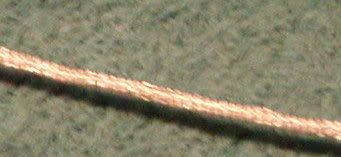
It was challenging to wind the exact pitch for the length to end up at 28.5" (the pitch needed to be .039"). I went beyond 28.5", and ended up having
to eliminate about 8" from the nichrome wire. So the resistance was a little lower, but I relaxed a little when I calculated that the design was only
slightly changed to 87 watts.
I then attached non-copper wires with high-heat sleeves to the nichrome ends, and then wrapped the connections with silver wrapping wire. After that,
I used another piece of the same fiberglass material used for the core, and worked it onto the element as a sleeve. This was much easier than I
thought would be, because when you push on the sleeve, it expands in diameter. The sheathed element was then shaped into a spiral. I held it on a 100
ml scrap flask, and put foil on it. This keeps the spiral immobile until I make the rest of the mantle, and also let me test it.
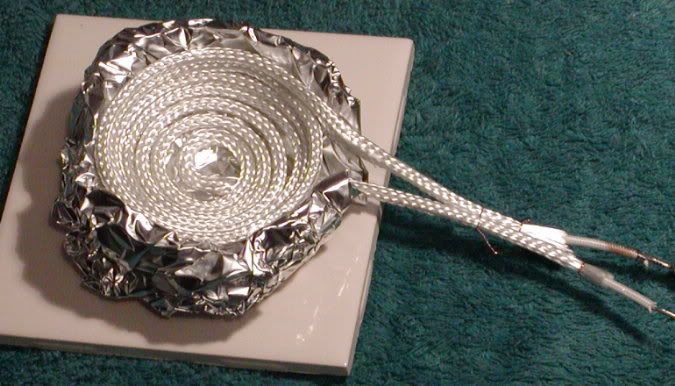
NOTE: The foil is temporary, and could pose a shorting hazard as wire whiskers can poke through this type of sheath.
I boiled some water - it works! The fiber material has something like glycerin or maybe pva on it, but it seems to heat off easily. The heat was very
even, and I was almost surprised to see how the bubbles came very uniformly from everywhere throughout the flask. I'd post the picture but you've all
seen boiling water before. Of course the foil would tend to even out the heat. I use a regular light dimmer installed in a box for control.
I'm still working on the rest of the mantle. I have a few ideas but still looking for small quantities of just that right fabric! I'm experimenting
with silicone coating some fabric for the bottom of the mantle.
|
|
|
BeerChloride
Harmless

Posts: 47
Registered: 17-9-2006
Location: Alabama, USA
Member Is Offline
Mood: Dunno
|
|
Concrete Mantle Body
I decided to try a concrete shell for the heating element I made. I cut the top off a bottle and used it as an outer mold. The inner mold was a 100 ml
flask padded with .1" of paper towels, wrapped in foil. Two holes were punched in the outer mold and straws used to keep the holes in the concrete.
After curing (concrete needs days of moisture to cure!) the heating element was put in:
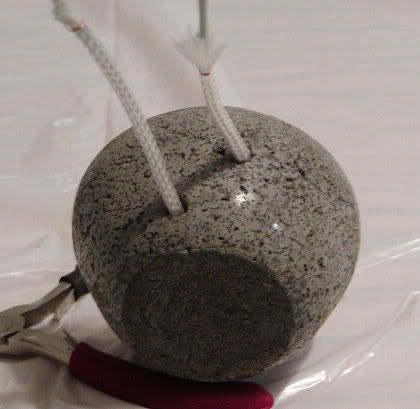
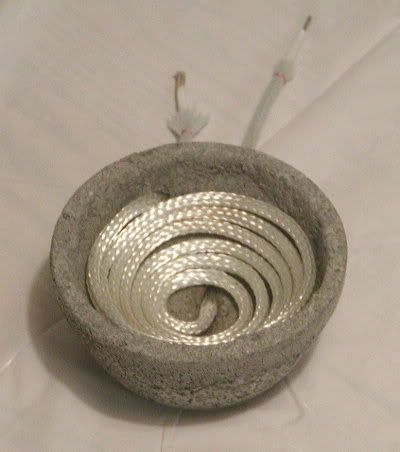
The heating element was sealed in place with small amount of automotive exhaust sealant, and then burned in for about an hour. The temperature of the
heating element maxed out at about 430 C (it was 57 F outside). At that temperature, the outside of the concrete was too hot to hold onto. Concrete
definitely has a lower R value than fiberglass.
Anyway, the hard part was how to attach some fabric. I thought about using silicone or a thin aluminum strip to seal the fabric edge right to the
concrete. I decided on steel epoxy which (JB weld) goes to 260 C, so I hope the outside of the thing won't get that hot.
It was a hassle. First I tied a steel wire around to hold the fiberglass on which I thought I had quite tight. To my dismay it simply fell off later.
I tried to use thin foam as masks to form a neat strip of epoxy, but because I had the seam so close to the top, the mask would tend to slide off. So
I took the masks off before the epoxy was set, and the fiberglass seam kept lifting off.  Well, the final solution of all this is that I wrapped a sheet of plastic (polyethylene) around it. Epoxy will not bond at all to PE so
when it set I just peeled it off. No nice, straight masking though. Well, the final solution of all this is that I wrapped a sheet of plastic (polyethylene) around it. Epoxy will not bond at all to PE so
when it set I just peeled it off. No nice, straight masking though.
I used double fabric and also layed another piece down inside before installing. Also, I used two sections of silicone insulation to cover the
fiberglass sheath fray used to cover the heating element. Here it is, ready for some type of connector:

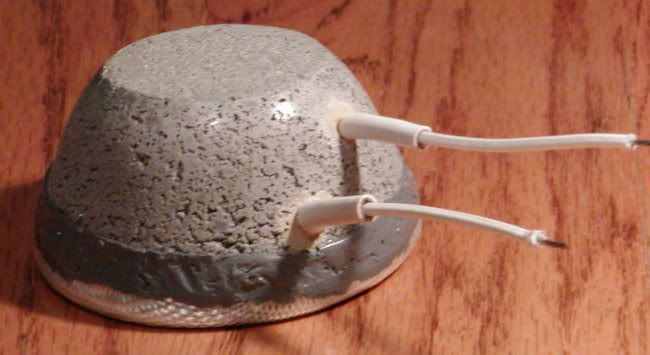

EDIT: Just did the final burn-in. Dissapointed. The steel epoxy on the outside kept giving off fumes and eventually was scorching, I
doubt it will cease to smell. The temperature of the epoxy was measured to be only around 160 C during this. 
[Edited on 10/11/2006 by BeerChloride]
|
|
|
mericad193724
Hazard to Others
  
Posts: 121
Registered: 4-6-2006
Location: New Jersey, USA
Member Is Offline
Mood: why do you care?
|
|
Awesome job BeerChloride!
You have inspired me and I will made a heating mantle for my 500ml RBF.
JB weld is not good for high temperature applications. I called the company once and they said it is not meant for high temperature. The way you
remove it is to heat it with a flame, it will smoke and decompose slowly. By heating up your mantle you are slowly removing it.
How many watts is good for a heating mantle used to distill liquids up to probably 200 C... 50W? 100W? 300W?
thanks
Mericad
|
|
|
12AX7
Post Harlot
    
Posts: 4803
Registered: 8-3-2005
Location: oscillating
Member Is Offline
Mood: informative
|
|
Pick up a thingie of "furnace cement". It's sticky and rated to 2700°F usually. Water glass based.
Tim
|
|
|
bio2
Hazard to Others
  
Posts: 447
Registered: 15-1-2005
Member Is Offline
Mood: No Mood
|
|
I got a few $5 warming plates by Royal for a source of heating cord/wire. It's 60 watts about 24inch fiberglass core and sleeve ready to go.
Two of these will boil a 2L flask full of water
with no problem. Several can be placed in the mantle and switched along with using a dimmer for heat control.
After 2 years of heavy use my 4 cord homemade mantle that takes a 1-3L round
flask has not failed me yet.
|
|
|
BeerChloride
Harmless

Posts: 47
Registered: 17-9-2006
Location: Alabama, USA
Member Is Offline
Mood: Dunno
|
|
Thanks, mericad193724! I'd like to see what you make.
Yeah, JB weld rates their product to 260 C, and it does seem to hold up quite well, but it does start to scorch WELL below this. I decided to keep my
element/concrete assembly and remove the fabric and epoxy, and had a hell of a time. It is very strong stuff indeed. First I chiseled most of it off,
then sanded down to the cement, then torched it with a propane torch. I was glad when that last bit turned white and it stopped stinking! I can use it
with no fabric, but I think I might try exhaust putty to attach some new fabric.
12AX7: Good idea. Furnace cement sounds like silica and sodium silicate - same stuff as exhaust putty which cost me $2 a tube. You probably get a
better deal with furnace cement. Incidentally, the putty I have does shrink some during drying.
Here's a link to glas-col which lists the wattage of their hemishperical mantles. The 500 mL is rated 270 watts.
http://www.glascol.com/products/heatimag/Fabricmantles1.html...
The wattage will in principle determine the RATE of distillation, but the element must be capable of going above the temperature you need. In
practice, I think it really depends on the geometry and the wattage - if you use glas-col's ratings it should work perfectly!
My concrete turned out REALLY strong. I figure the key is to keep the concrete hydrated while it sets. I kept the one I did wrapped in plastic for
days, and after 24 hours I would spray it to keep it moist.
One thing, though: I don't really like how a concrete mantle gets hot compared to an all-fabric one.
One other thing, I think Jameco just recently started carrying a two-prong "Jones plug" with a locking feature. Haven't found a photo yet. It's like
$5.
|
|
|
uchiacon
Hazard to Self
 
Posts: 87
Registered: 3-7-2009
Location: The Jungle(neezeelund)
Member Is Offline
Mood: Financial
|
|
K so I've been making my heating mantle, I started off with my 1L RBF and painted it with a graphite slurry(this method doesnt work so well, I'll tell
you later). The graphite slurry was made with powdered graphite gouging rods, got a file and powdered about 5cm worth of a 9mm rod. Mixed it will
water to get a thick slurry, similiar to paint.
Applied it to the bottom half of flask, then I applied a thin layer of refractory/furnace cement, that sticky shit you get in the hardware store(my
god its sticky) and then when that had dried for about 15min I pressed in 3.2m worth of 28 gauge nichrome wire.applied another thin layer then I made
sure that any of the wires werent touching.
This was about the time that I came to the conclusion of "oh f.."
because the refractory was sticking quite nicely to the glass, and parts of the graphite paste underneath had been disturbed. I'm thinking that its
going to be hard to remove the RBF from the furnace lining shell...
For anyone else, don't use a grapite paste as a mold release agent, only use wax or a layer of cellophane(not sure on this one, but I think it would
work nicely and cleanly).
I'm planning on up to 400W(i'l only be using about 200ish for nitric distillation) on a 500W light dimmer with a switch. The wire has a resistance of
13.77 ohms per meter.
|
|
|
entropy51
Gone, but not forgotten
    
Posts: 1612
Registered: 30-5-2009
Member Is Offline
Mood: Fissile
|
|
My suggestion for a mantle replacement is to get several sizes of hemispherical steel mixing bowls that are just slightly larger than the round-bottom
flasks you wish to heat. Clamp the flask so that is centered in a steel bowl slightly larger than the flask. Pour in fine clean sand to fill the
void between flask and bowl, it shouldn't be a thick layer, sand is not a good conductor of heat. A 1/2 inch thick layer of sand works well. Fine Cu
metal shot, or Cu powder (made by displacement with steel wool and CuSO4 solution) would probably be better than sand.
Heat the steel bowl on a metal-top hotplate. Ceramic top hotplates are in danger of breaking if overheated. Slowly warm up the sand bath, they heat
slowly so go slow so as not to overheat the sand. An old-fashioned hot plate with an exposed spiral coil of wire as a heating element, connected to a
variac, works well.
I have used such a sand bath for distilling nitric and other things. You just need to be patient while heating the sand up to the desired
temperature.
|
|
|
1281371269
Hazard to Others
  
Posts: 312
Registered: 15-5-2009
Member Is Offline
|
|
Wouldn't displacement with steel wool leave carbon too?
I was wondering - surely copper wire in a spiral around a RBF would greatly increase heating efficiency if one were using an open flame as the heat
source. Is this worth a try?
|
|
|
Sedit
International Hazard
    
Posts: 1939
Registered: 23-11-2008
Member Is Offline
Mood: Manic Expressive
|
|
Why would a displacement reaction between CuSO4 and steel wool leave carbon Mossy? I think there may be some confusion.
Knowledge is useless to useless people...
"I see a lot of patterns in our behavior as a nation that parallel a lot of other historical processes. The fall of Rome, the fall of Germany — the
fall of the ruling country, the people who think they can do whatever they want without anybody else's consent. I've seen this story
before."~Maynard James Keenan
|
|
|
1281371269
Hazard to Others
  
Posts: 312
Registered: 15-5-2009
Member Is Offline
|
|
Steel wool contains carbon, and all the iron in the steel wool reacts to form FeSO4 or Fe2(SO4)3 displacing the copper, so surely the carbon would be
left?
|
|
|
kclo4
National Hazard
   
Posts: 916
Registered: 11-12-2004
Location:
Member Is Offline
Mood: No Mood
|
|
Probably, but not enough to matter and it would probably be conductive anyways..
|
|
|
entropy51
Gone, but not forgotten
    
Posts: 1612
Registered: 30-5-2009
Member Is Offline
Mood: Fissile
|
|
I didn't say it was 99.99% pure Cu.
Even if the steel wool is carbon steel, it wouldn't contain more than a few percent of carbon. And Steel wool may be iron instead of steel? When I
make Cu flakes by the displacement method I wash it repeatedly with water, but it doesn't appear to contain visible carbon particles. If you really
wanted to free it from carbon, heat the Cu in a crucible. The C should burn off, but some CuO will be formed as well.
The sand probably contains as much C impurity as would the Cu. It smokes a tad the first time it is heated, but not after that.
Better to remain silent and appear a fool than to open your mouth and remove all doubt.
|
|
|
| Pages:
1
2 |